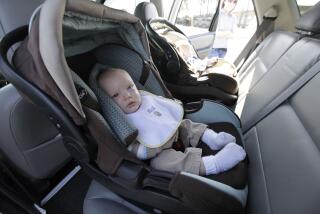Children Buckled in Car Seats in Record Numbers, Study Says
- Share via
WASHINGTON — A record number of children are now riding safely buckled in car seats and seat belts, but too many are still in the front seat, where they are at increased risk, according to a survey released Monday.
As the government kicks off Child Passenger Safety Week, the good news is that the number of children killed in car accidents has dropped steadily since 1995 -- a trend that experts attribute to more widespread use of child safety seats and seat belts. Still, motor vehicle crashes remain the leading cause of death in children ages 4 to 14.
Today, 99% of infants, 94% of toddlers and 83% of 4- to 7-year-olds are riding properly restrained in safety seats or seat belts, according to a June 2002 survey by the National Highway Traffic Safety Administration, which is part of the Department of Transportation. Though all are improvements since the agency’s last survey in 2000, officials hope to bring all categories to 100% by raising public awareness and bolstering enforcement of car safety laws.
“Restraint use among children has reached record levels, but unfortunately, all the news is not good,” said Chuck Hurley, executive director of the Air Bag & Safety Campaign of the National Safety Council. “Parents are still placing children in the front seat, placing them at increased risk of injury or even death.”
According to the survey, 15% of infants under 12 months, 10% of toddlers ages 1 to 3 and 29% of 4- to 7-year-olds still ride in the front seat.
State laws on child restraints vary. In California, any child under the age of 6 and weighing 60 pounds or less must be restrained in a car safety seat. For children 6 or older or more than 60 pounds, either a seat belt or a car seat may be used.
The California Highway Patrol recommends that children younger than 1 year and weighing up to 20 pounds ride in a rear-facing car seat in the back seat of the vehicle. The federal safety agency goes even further, urging parents to keep children 12 and under in the back at all times.
“Children ages 12 years and under should never be placed in the front seat of the vehicle. This is true every time, for every trip,” said Jeffrey Runge, an official at the agency.
Rear seats are 35% safer than front seats for passengers of all ages, according to research from the Insurance Institute for Highway Safety.
Although children are always safer in the back seat, only Delaware and Rhode Island require that they be seated there. But because the laws took effect only in the last two years, it is too early to judge their effectiveness.
A federal law known as LATCH, for Lower Anchors and Tethers for Children, requires all cars, minivans and light trucks manufactured after Sept. 1, 2002, to have metal anchors and all child safety seats made after the same date to have attachments to fit the anchors, thus making it easier for adults to correctly install a car seat. The agency has found that 80% of car seats are installed incorrectly, leading to an estimated 68 deaths and 874 injuries each year.
The survey also found that children are far more likely to be restrained when the driver buckles up. More than 90% of belted drivers -- but only about 70% of unbelted drivers -- restrain the children riding in their vehicles.
The most effective way to protect children is to pass primary adult belt laws, Hurley said. Eighteen states, including California, and the District of Columbia require drivers to wear seat belts. California has the second-highest rate of seat belt use in the country, next to Washington state, with 91.1% of Californians buckling up, according to the Office of Traffic Management.
Air bags also pose less of a threat when children are properly restrained.
Fatalities caused by air bag deployment have dropped 94% in the last six years, even as the number of vehicles with passenger-side air bags increased fivefold. During the same period, there has been a 10.7% reduction in fatalities of children under 12, Hurley said.
More to Read
Sign up for Essential California
The most important California stories and recommendations in your inbox every morning.
You may occasionally receive promotional content from the Los Angeles Times.













